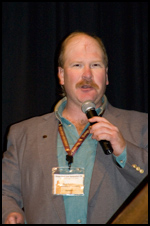RBCS XXI coverage:
Range-based Heifer Development
Producers may want to reconsider breeding weight targets for heifers.
![]() How big should replacement heifers be at breeding time? The rate of postweaning growth among heifer calves has long been considered an important factor affecting age at puberty. Research conducted during the late 1960s and through the early 1980s indicated puberty occurs at a genetically predetermined size, and only when heifers reached an appropriate weight could high pregnancy rates by achieved.
How big should replacement heifers be at breeding time? The rate of postweaning growth among heifer calves has long been considered an important factor affecting age at puberty. Research conducted during the late 1960s and through the early 1980s indicated puberty occurs at a genetically predetermined size, and only when heifers reached an appropriate weight could high pregnancy rates by achieved.
Based on that research, it has long been recommended that heifers be developed to reach 60%-65% of expected mature weight before breeding.

"Heifers developed on the same type of feedstuffs they are likely to receive after maturity appear to be better adapted to their environment," said UNL's Rick Funston.
However, according to University of Nebraska-Lincoln (UNL) Reproductive Physiologist Rick Funston, subsequent research suggests reconsideration of target weight guidelines. In a presentation during the 2009 Range Beef Cow Symposium in Casper, Wyo., Funston said rising feed costs have prompted consideration of development systems utilizing low-cost feedstuffs, including range or grazed crop residues, and target weights ranging from 51% to 57% of expected mature weight.
Funston said traditional guidelines were appropriate when they were established, but genetics and selection for replacement females have changed over time. Current research has shown that feeding heifers to traditional target weights increased development costs relative to more extensive development systems where heifers were developed to lower target weights. Funston cited research suggesting growth from birth to weaning may be more critical than postweaning gain, and age at the beginning of breeding season is more critical than body weight.
According to Funston, heifers developed on the same type of feedstuffs they are likely to receive after maturity appear to be better adapted to their environment. They are likely to be more efficient and stay in the herd longer than heifers developed under a more intensive system. In addition to lower maintenance requirements and increased longevity, the heifers' offspring may also be better adapted, perhaps due to fetal programming.
In addition, when heifers are developed to lower target weights, at a lower cost, but do not become pregnant during a relatively short breeding season, the open heifers may represent a profit center when sold as feeder cattle.
"Heifers may be developed to lighter weights without negative effects on profitability or productivity," Funston said. "But a key point to remember is that heifers must continue to grow throughout their first pregnancy to be productive, so they must be managed accordingly."
For more coverage from Range Beef Cow Symposium XXI, visit www.rangebeefcow.com.
Comment on this article.




